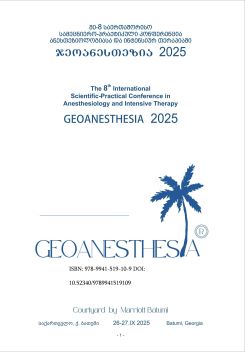CYTOKINE PROFILE IN ISCHEMIC STROKE
DOI:
https://doi.org/10.52340/9789941519109.21ანოტაცია
Introduction: In recent years, the discovery of biomarkers and novel therapeutic approaches for stroke has become the subject of intensive research. The pathophysiology of ischemic stroke involves complex inflammatory processes in which cytokines—soluble glycoproteins produced by brain cells—play a crucial regulatory role. Understanding the balance between pro-inflammatory and anti-inflammatory cytokines during different phases of stroke can contribute significantly to prognosis and the development of immunomodulatory therapies, Consequently, a better understanding of the roles of pro-inflammatory and anti-inflammatory cytokines produced during stroke can help clarify how inflammation contributes to the progression of ischemic injury. Furthermore, this knowledge could enable the identification of new therapeutic targets and biomarkers essential for prognosis. [1]
Cytokines are soluble glycoproteins produced by brain cells in response to ischemic injury, and they regulate both innate and adaptive immune responses. Microglia, astrocytes, endothelial cells, and neurons in the brain produce both pro-inflammatory and anti-inflammatory cytokines. An increase in pro-inflammatory cytokine production and a decrease in anti-inflammatory cytokines are correlated with larger infarct sizes and worse clinical outcomes in animal models. [2]
Research Objective: The aim of this research is to investigate the activity of pro-inflammatory and anti-inflammatory cytokines during the early and later stages of acute ischemic stroke, to evaluate their role in pathophysiological processes and their potential significance in the development of immunomodulatory therapies.[3]. The study also seeks to assess the possibility of predicting disease outcomes based on cytokine profiling and to create a theoretical foundation for the development of treatment strategies.
Methods: The research will be conducted in three study groups:
- Patients who have undergone thrombolysis
- Patients who have undergone thrombectomy
- Patients receiving only conservative treatment (anticoagulant/antiplatelet therapy)
The study will be ongoing, prospective, observational, and will include both clinical and laboratory components. Patients with confirmed ischemic stroke will be divided into acute and subacute phase groups based on cytokine activity and the timing of activation. Samples will be collected and further monitored accordingly. The target number of patients is approximately 50–60.
Expected Results: Within the framework of this study, quantitative determination of pro-inflammatory and anti-inflammatory cytokine concentrations in the serum of patients with ischemic stroke is expected using the ELISA method. Analysis of the obtained data should reveal dynamic changes in cytokine activity, allowing for their potential use as biomarkers to predict the severity of ischemic injury and assess pathophysiological processes. This could lay the groundwork for developing immunomodulatory therapeutic approaches.
წყაროები
2017 Aaron L. Berkowitz, MD, PhD -Clinical Neurology and Neuroanatomy A Localization-Based Approach . (© 2017). McGraw-Hill Education.
Clinical Commissioning Policy: Mechanical thrombectomy for acute ischaemic stroke (all ages). (January 2018 ). NHS England .
Cytokines: their Role in stroke and potential use as Biomarkers and Therapeutic targets. (2014 oct). Danielle Ndoll, Tayra Lbar, James W Simpkins.





